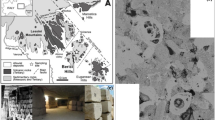The following processes occur in talc stone (carbonate-chlorite-talc composition) and accompanying tremolite-chlorite rocks, studied in the present work, in the temperature interval 950 – 1100°C as a result of the decomposition of talc and tremolite: dehydration (talc, tremolite, chlorite), decarbonization (dolomite, calcite, breunnerite), and formation of new crystalline phases (forsterite, enstatite, clinoenstatite, subcalcium augite). These processes, as well as the presence of an amorphous phase enriched with magnesium ions, make ceramics stronger. Larger-size little-changed grains of tremolite are an additional strength-increasing factor. Owing to their tablet and needle shapes such grains reinforce the ceramic structure.


Similar content being viewed by others
Notes
Here and below, content by weight.
References
I. Ya. Guzman (ed.), Chemical Technology of Ceramics [in Russian], RIF “Stroimaterilay,” JSC, Moscow (2003).
V. I. Sokolov, Talc-Chlorite Schists of Karelia and Their Complex Applications [in Russian], KarNTs RAN, Petrozavodsk (1995).
V. V. Shchiptsov, G. A. Lebedeva, and V. P. Il’ina, “Prospects for using mineral-raw materials resources of Karelia for the production of building materials,” Stoit. Mater., No. 5, 8 – 10 (2008).
V. P. Il’ina, G. A. Lebedeva, G. P. Ozerova, and I. S. Inina, “Use of technogenic mineral raw materials of Karelia for manufacture of ceramic tiles,” Stroit. Mater., 47 – 49 (2006).
A. I. Avgustinik, Ceramics [in Russian], Stroiizdat, Moscow (1975).
E. K. Lazarenko, Course in Mineralogy [in Russian], Moscow (1971).
W. A. Deer, R. A. Howie, and J. Zussman, Rock-Forming Minerals, Vol. 2, Chain Silicates [Russian translation], Mir, Moscow (1965).
T. V. Vakalova, et al., “Controlling building and heat-insulation ceramics quality by mix composition design,” Stroit. Mater., No. 2, 27 – 30 (2007).
Bai Zhimin and Ma Hongwen “Effect of diopside on the characteristics of three-component ceramic obtained from a quartz – clay – feldspar mixture (China, China University of Geosciences, Beijing), Guisuanyuan xuebao (J. Chinese Ceram. Soc.), 31(2), 148 – 151 (2003).
V. P. Il’ina and G. A. Lebedeva, “Use of wastes from concentration of alkali syenites from the elet’ozerskoe deposit for manufacturing of ceramic tiles,” Glass Ceram., 67(7 – 8), 199 – 202 (2010).
Author information
Authors and Affiliations
Corresponding author
Additional information
Translated from Steklo i Keramika, No. 11, pp. 22 – 25, November, 2011.
Rights and permissions
About this article
Cite this article
Il’ina, V.P., Lebedeva, G.A. Effect of talc stone and chlorite-tremolite rock on ceramic tile phase composition and properties. Glass Ceram 68, 369–372 (2012). https://doi.org/10.1007/s10717-012-9392-6
Published:
Issue Date:
DOI: https://doi.org/10.1007/s10717-012-9392-6




